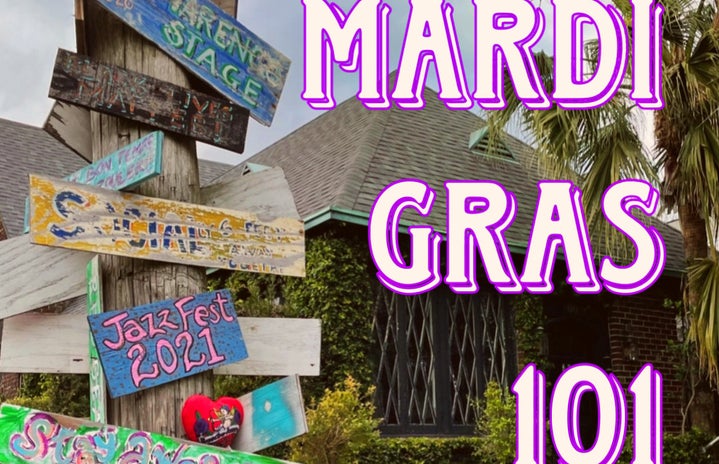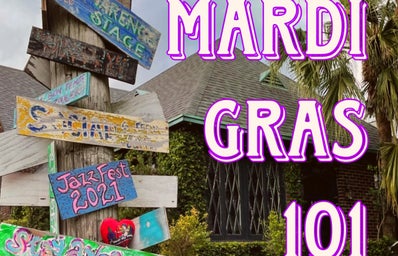Once the clock hit midnight and the celebration for the New Year began, my mind couldn’t help but veer into the thought of Mardi Gras. If you’re a student at LSU, I bet your mind wasn’t far off from where mine was.
My first Mardi Gras was last year, and it was not a normal experience whatsoever. I’m an out-of-state student and grew up in California and Virginia (very different and far, I know), so my knowledge of the celebration was not the best. Lucky for me, though, my freshman-year roommate grew up and spent most of her life in New Orleans, so she had more than enough of her own experience to guide us both through one together.
Not only did she give me the best first Mardi Gras, but she also shared pieces of New Orleans’ culture and history by telling me about her past experiences. The most notable story she shared—simply because of how funny it is to me—is the story of how she got the scar on her left index finger.
Her hand slipped when she was cutting a slice of king cake…yeah.
You’re probably wondering what king cake is—don’t worry, I’ll get into it soon. I had the same look of confusion on my face when she first told me the story.
So, Sophie Simpson (my freshman-year roommate) told me everything I needed to know to make it through the celebrations. Were we back and forth between our dorm in Baton Rouge and her family friend’s home in New Orleans at first? Maybe…but that didn’t stop us from having the best time.
Reflecting on my first Mardi Gras made me think, what would it have looked like if I didn’t have my roomie holding my hand through the whole thing? Let’s just say, I don’t want to know.
With that, I bet there are a few questions my first-time Mardi Gras goers have at this point. I had my “lucky me” moment last year, but I’m here to save you from needing one of those. Let’s get into all the Mardi Gras must-knows!
What is Mardi Gras? What’s the purpose of the celebration?
Mardi Gras is a celebration that occurs every year leading up to the Christian tradition of Lent. Mardi Gras is also French for “Fat Tuesday.”
“The term refers to the practice of feasting on the day before Ash Wednesday,” Simpson, a New Orleans native, said. “The name represents the idea of stuffing your face with rich, fat foods before the fasting season begins.”
Mardi Gras typically falls on a different date every year because of its alignment with Easter, but down in New Orleans, it doesn’t seem to matter too much when you begin celebrating.
“I’m pretty sure it’s like, kind of as far as New Orleans people, as soon as Christmas is over, it’s Mardi Gras,” Julianna Shipp, a Belle Chasse native, said. “So you have that almost month or so of celebrations right before Lent, and then you have Lent and then you have Easter.”
What is the significance of the colors?
Simpson, Shipp, and Kaleigh Maher grew up in or around New Orleans and they all shared that they remember learning how purple is for justice, green is for faith and gold is for power.
These colors were established as the Mardi Gras colors because of the Rex parade in 1872, according to historian Errol Flynn Laborde.
“I’ve also heard that the purple stands for luxury and royalty, which would make sense when it comes to Mardi Gras balls,” Maher, a Covington native, said.
What are some of the most popular parades?
There are going to be parades all over the city; to help prevent any overwhelming feeling of having too many options, here’s what my Louisiana ladies cut it down to for you.
“The most popular parades that everyone knows about are Endymion, Bacchus, and Orpheus, which are all just krewes who put on the parades,” Maher said, ” I find the ones with the huge crowds to be the most fun, so these are where it’s at.”
Shipp also highlighted Endymion as the most popular parade.
“The most popular parade is definitely Endymion,” Shipp said. “Endymion is a big one, okay, that’s an uptown parade. It’s so much fun. Everyone in the city knows when Endymion is and everyone goes there. That’s the big parade, and then some other big ones: Cleopatra is a good one; Bacchus is pretty good; Muses is a popular one.”
Simpson also shared that most parades have a “famous throw.”
“Zulu has coconuts and Muses has shoes,” she said.
What is king cake?
King cake, in a sense, is the Mardi Gras dessert. You can’t go to Mardi Gras and not have king cake—it’s the rules.
“I’m pretty sure the original [king cake] is cinnamon with the purple, green, and gold sprinkles,” Maher said, “but there is also cream cheese, raspberry, pecan praline [and more]. My favorite is cream cheese filling.”
“For someone’s first time trying it, I would either give the classic cinnamon because it’s the original… [or] the brand Randazzo’s because it’s softer and has more of a creamy icing,” Maher said.
When I asked Shipp for anything else she wanted to share about Mardi Gras, she gave me the rundown on king cake’s origin.
“I think a lot of people don’t realize there’s actually a meaning behind the king cake,” Shipp said. “People just think it’s a dessert, which, I mean, it is, but there is a meaning. It represents the three kings that visited Baby Jesus when he was born.”
Not only is king cake a delicious dessert with a religious origin story behind it, but it also throws in a fun Mardi Gras tradition for friends and families.
How’s that?
Well, the plastic baby in the cake, of course.
“The plastic baby in the king cake obviously represents Baby Jesus, and if the baby is in the piece of king cake that you get, then it’s supposed to bring luck and prosperity,” Shipp said.
Maher also tapped in and shared that the king cake tradition at school and parties was “whoever got the baby had to bring the next king cake for [everyone].”
Any random pieces of information to keep in mind?
Mardi Gras is traditionally a religious celebration, but the reason for celebration has evolved over the years, and “not many people see it that way” in terms of simply a religious holiday, according to Shipp.
“[For] most people who aren’t religious, it’s just a reason for fun and celebration and, you know, just it’s a fun season, she added. “Most people celebrate Mardi Gras. You don’t have to be religious to celebrate.”
The Mardi Gras fun is for everyone to enjoy, and to help make sure you enjoy it fully, there are a couple of random necessities to check off the list before officially hitting the streets.
Maher’s top tip is to make sure you have access to a bathroom somewhere before you find a spot. Speaking from experience, this should be one of the first things you do. Trust me, the porta-potties will not be to your liking.
Before you get out of the house to go searching for a spot and a bathroom, there’s one more thing you better have on hand.
“Bring a bag for what you catch,” Maher said. “Those beads will be super heavy around your neck and you’ll also catch other things like cups and stuffed animals.”
And lastly, it’s important to respect the history of Mardi Gras’ initial meaning. While out in the streets catching beads and making memories, don’t forget to appreciate the significance of what fuels the fun.
“Mardi Gras is so rich in history and has so many interesting aspects to it,” Maher said, “such as Twelfth Night, masks—which is a law that float riders must wear them—kings and queens, beads, krewes, balls…I could go on and on.”
There you have it! You officially know the Mardi Gras 101 and are suited for a trip to New Orleans. It may not be the same as having a New Orleans-born-and-raised roommate by your side, but you’ll be just fine.


